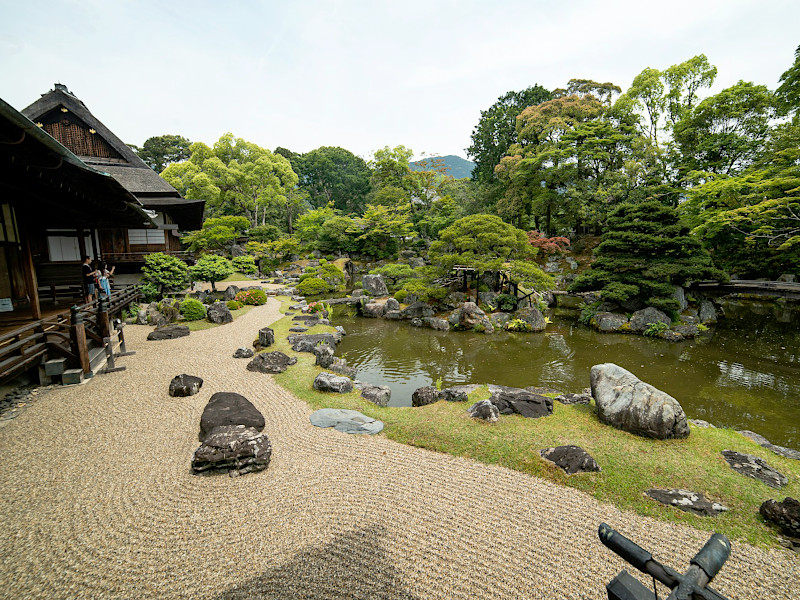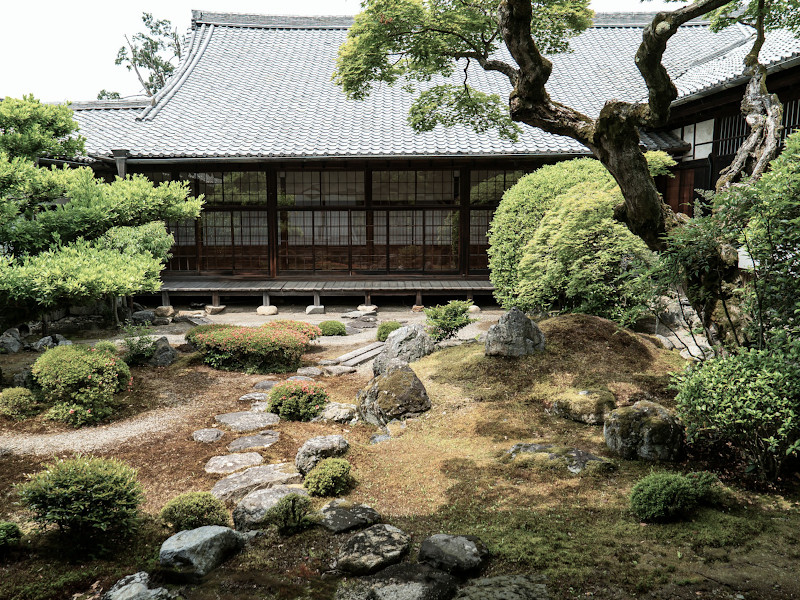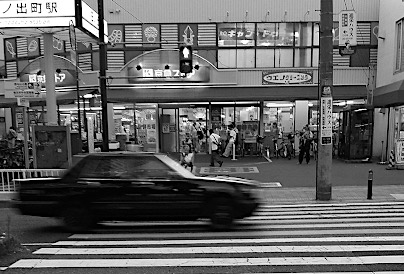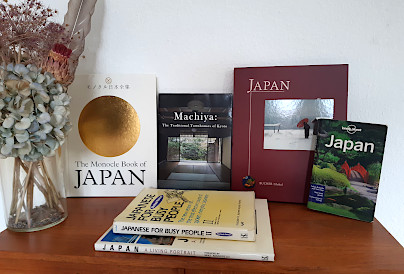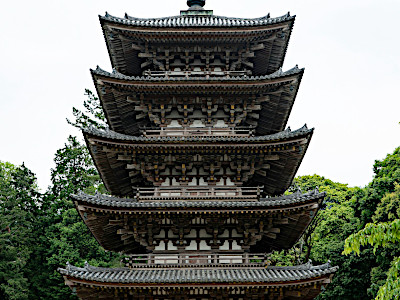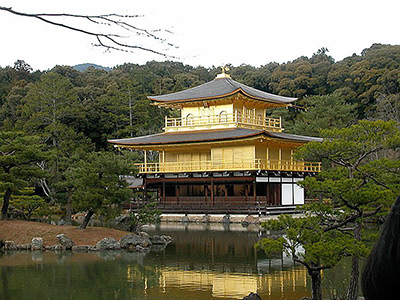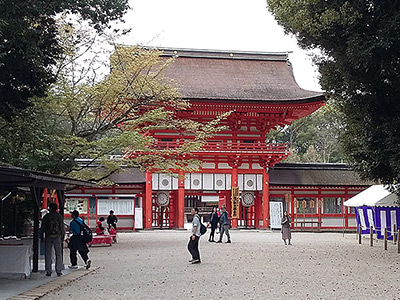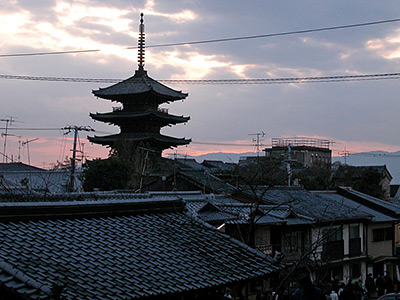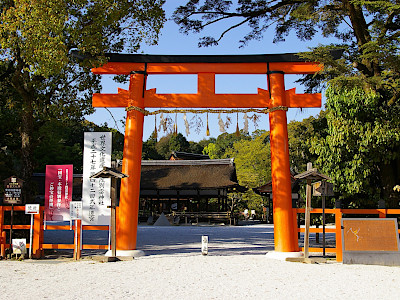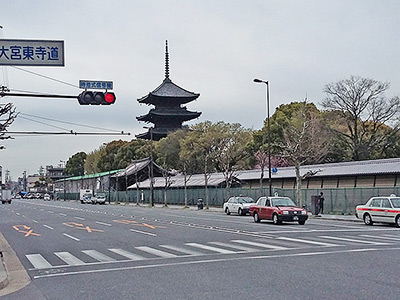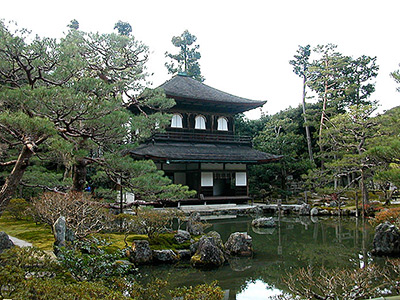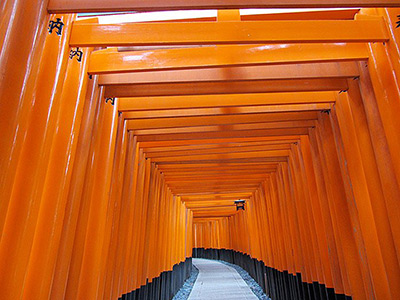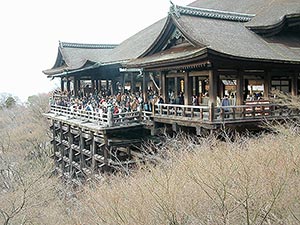Sanbo-in Temple in Kyoto
This post can contain affiliate links, which means that we may receive a small commission if you make a purchase using these links.
Facts & Figures
Sanbo-in Temple, known as the House of the Three Treasures, is a sub-temple of Daigoji, a UNESCO World Heritage Site, in the southeast part of Kyoto. Its main attraction is the beautiful garden, which covers an area of 5000 square meters, designed by daimyo Toyotomi Hideyoshi (1537 – 1598). It is a place of particular scenic beauty within the country and is designated as a special historic spot.
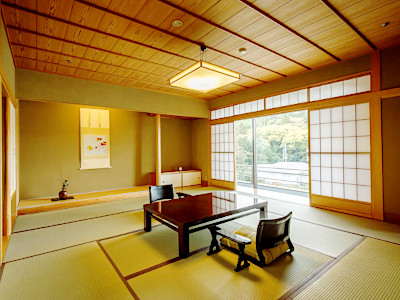 Explore Ryokans in Kyoto >
Explore Ryokans in Kyoto >
Ryokans are the perfect way to discover old Japanese culture and traditions.
The Karamon (entrance gate) and the Omote-Shoin building have the status of National Treasures. Many other buildings within the temple grounds, like the Aoi Chamber (Aoi-no-ma), Akigusa Chamber (Agigusa-no-ma), and Chamber for the Imperial Messenger (Chokushi-no-ma), are designated as important cultural assets. Unfortunately, it was not allowed to take pictures within the buildings. Another highlight is the amazing sliding door paintings (fusuma-e) made by Kano school artists, which was the most famous school of Japanese painting from the late 15th century until the beginning of the Meiji period (1868). The countless cherry and plum trees within the temple area make this place the perfect spot to enjoy the cherry blossom season in Kyoto in late March and the beginning of April.
- Sanbo-in Temple:
- Opening Hours - 9:00 am to 5:00 pm (March - November, last entry 4:30 pm)
- Opening Hours - 9:00 am to 4:00 pm (December - February, last entry 3:30 pm)
- Closed - never, open every day
- Admission Fee - 500 yen (Adults)
My tips for local activities
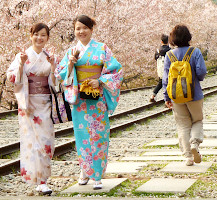
How about exploring the best parts of my favourite city Kyoto with a local guide? The personalized tour by our partner GetYourGuide can take between 2 - 8 hours. For more details check out this page >
History
Sanbo-in was constructed in 1115 during the Heian period (794 - 1185) by Shokaku, the 14th archbishop of the Daigoji Temple. It was used over the years as the head priest's residence. During the Onin War (1467 - 1477) the Buddhist temple was partly destroyed. Daimyo and warlord Toyotomi Hideyoshi (1537 – 1598) gave the order to rebuild and expand the temple in 1598 during the Azuchi–Momoyama period (1568 - 1600). Toyotomi Hideyoshi wanted to use this place for his tea parties and famous cherry blossom viewings. The garden design was finalized in 1618 (20 years after the death of Hideyoshi) by Yoshiro. His excellent work was rewarded with the honorary title of Kentei, which means Excellent Gardener.
Location

Sanbo-in Temple is located within the Fushimi Ward in the southeastern part of Kyoto at the base of Mount Daigo.
Address: 22 Daigohigashiojicho, Fushimi Ward, Kyoto, 601-1325
How to get to Sanbo-in Temple?
- 10min walk from Daigo Station on the Tozai Subway Line to Sanbo-in Temple
Sightseeing spots at the Sanbo-in Temple area
Top:
Temple Garden - The beautiful garden with its nearly 800 stones, which were collected from feudal lords from all over Japan, was designed in a way that it could be enjoyed from within the temple buildings. Daimyo Toyotomi Hideyoshi donated one huge rectangular stone called Fujito-no-Ishi or Sengoku-no-Ishi from his private residence Jurakudai. Even a Noh play was written about this stone. Enjoy the beautiful pond with the islands Kameshima and Tsurushima, a waterfall (Sandan-no-Taki), and bridges.
Karamon - This gate, also known as chokushimon, is a National Treasure. It opened its doors only for the Imperial messengers. It had a black-lacquered design with golden motifs dating back to the Azuchi–Momoyama period (1568 - 1600).
Omote-shoin - The main drawing room, a National treasure, offers perfect views of the garden. The house was constructed in the shinden-zukuri style, which was popular during the Heian period (794 - 1185). The building consists of lower (gedan), middle, and upper rooms. The lower room or Agebutai-no-ma can host a Noh stage. The beautiful sliding door paintings (fusuma-e) have the status of important cultural assets and were created by painter Ishida Yutei (1721 - 1786) and artists related to Japanese painter Hasegawa Tohaku (1539 - 1610).
Hondo - Within the main hall you will find the Mirokubosatsu (Maitreya bodhisattva) statue, the principal image, carved at the end of the 12th century by Japanese sculptor Kaikei.
Kokeniwa - The garden near the main hall (Hondo) is also known as Sakazukushi. Its main parts are only white sand and moss.
Houkoku Daimyojin - The small shrine is dedicated to daimyo Toyotomi Hideyoshi (1537 – 1598). He was the main force behind the restoration of the whole Daigoji temple complex including Sanbo-in.
Chinryutei - The beautiful teahouse can be found in the southeast part of the garden.
Festival & Events in Kyoto (dates can change without notice)
April
Miyako Odori (1st - 31th)
The traditional annual spring dance of the Kyoto district Gion Kobu performed by Geiko and Maiko is a must-see on your Kyoto visit. Don't miss the most popular dances the Miyako Odori "Cherry Blossom Dances" or "Dances of the Old Capital" at the Gion Kobu Kaburenjo Theater (located close to Gion Corner).
Hotaiko Hanami Gyoretsu at Daigoji Temple (14th)
This event is in memory of the largest tea and cherry blossom party from 1598 held by daimyo Toyotomi Hideyoshi for 1300 guests. Enjoy the procession (150 participants wearing historical costumes), performances, and party which last from 1:00 pm - 3:00 pm.
May
Aoi Matsuri (15th)
The highlight of this festival is a large parade from the Imperial Palace through the Shimogamo Shrine to the Kamo Shrines. More than 500 people wearing aristocratic costumes from the Heian Period (794 - 1185). The Aoi Matsuri belongs with the Gion Matsuri and Jidai Matsuri as the three most famous festivals in Kyoto.
July
Gion Matsuri (whole month)
The month of July is full of different events like the Yoiyama - Kyoto's Magical Night (locals in kimonos look at the giant Gion floats the day before the parade) or the famous Yamaboko Junko (float procession on the 17th of July).
October
Jidai Matsuri ("Festival of Ages") (22nd)
People celebrate with a large parade between Imperial Palace to Heian Shrine the anniversary of the foundation of Kyoto. App. 2000 participants wearing historical costumes from different time periods. Enjoy this great festival which lasts around 2 hours. Illumination event at Kodai-ji (end of October - beginning of December)
Where to stay in Kyoto?
Day trips from Kyoto:
My 100 Best Moments in Japan
I have visited Japan nearly every year since 2004. This is my collection of the 100 best moments in my favorite country. Enjoy the pictures and I hope you will start your own journey soon.
Find out more >
Books about Japan
Reading books is a great source of inspiration for me. Check out my recommended list of books about the fascinating country Japan.
My Book recommendations >

